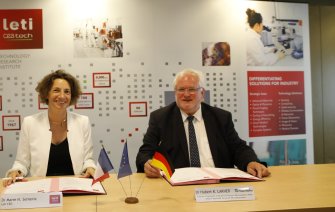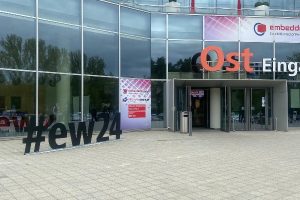 “In Europe we face two challenges: maintaining capability and maintaining manufacturing,” said Leti CEO Marie-Noelle Semeria.
“In Europe we face two challenges: maintaining capability and maintaining manufacturing,” said Leti CEO Marie-Noelle Semeria.
“Otherwise,” added Hubert Lakner, chairman of Fraunhofer’s microelectronics group, “Europe will become what it is geographically, an appendage of Asia.”
Semeria spoke of national and European security and defence: “We need the independent capability to make certain components for security and defence,” she said. “We need to keep the knowledge of advanced technologies, keep the technology, and keep the capability.”
Semeria also spoke of the high-cost of modern chip development, and the need to support SMEs in developing of their products. Leti is a government-funded lab, and she sees this support as part of its remit.
The idea is that France and Germany will pool research and technology organisations (‘RTOs’) with the aim of leading in the design and manufacture of sensors, power electronics and FDSoI (fully-depleated silicon-on-insulator) semiconductors.
These have been dubbed the ‘three pillars’ of the project, and are prime technologies for IoT hardware.
Finfet CMOS – the technology which vies with FDSoI to be the technology in next-generation ICs – is not amongst the pillars. “TSMC is running with CMOS up to the end of Moore’s Law. This is not the route of Europe,” said Semeria.
With finfet better-suited to high speed and FDSoI better-suited to low power, in application terms this would broadly leave Asia with phone chips and Europe with IoT chips.
Of the three pillars, according to Leti’s Semaria, Europe is already leading in power and sensors.
In a separate but related EU initiative, six nations are getting together.
It appears that this Franco-German initiative is related to an un-named wider initiative amongst six countries in the EU.
German-French pooled resources include some big manufacturers, including Infineon, Bosch, Global Foundries, X-Fab, and Soitec.
According to Lanker, Germany has already put €1bn into the project this year – the large investments in Global Foundries’ Dresden fab and the Bosch fab are part of the wider plan. In has also put €350m towards a German research fab, supported by Fraunhofer and Leibnitz Institutes.
Germany has gone out on a limb here, risking the wrath of the European Commission over state aid its manufacturing industry, ahead of an expected European mechanism to legitimise such behaviour – but no one at the launch expected trouble. They are “anticipating a green light” according to Lanker and Samaria.
This mechanism would allow state aid to the electronics industry and, it appears from statements made at the Leti-Fraunhofer announcement, involves six countries – ironically, in the face of Brexit, including the UK.
An un-named British company – speculated to be Welsh wafer specialist IQE – was, and perhaps still is, due to lead a compound semiconductor project.
One country not involved is Belgium, on whose soil sits arguably the greatest semiconductor research lab in the world – IMEC.
No French money has appeared yet, but now its government upheaval is over talks between it and Leti have re-commmenced.
Both Leti and Fraunhofer expect their collaboration to be a subject of discussion at a summit between the German and French governments in two week’s time.
Is the project expecting European funding – not yet. “We hope, perhaps in a second step, we will get some European money,” said Semeria.
Updated by Steve Bush
Image: Leti CEO, Marie-Noelle Semeria with Hubert Lakner from Fraunhofer Group for Microelectronics (Photo: Pierre Jayet) – Photo: Pierre Jayet
 Electronics Weekly Electronics Design & Components Tech News
Electronics Weekly Electronics Design & Components Tech News




Is SOITEC’s Smart Cut technology the best for FD-SOI application? Which other companies could develop similar technology?